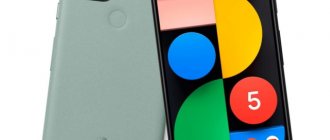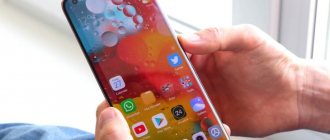This calendar year, Xiaomi has traditionally released a ton of smartphones, from budget to premium.
The release of Xiaomi Mi A1 caused a great resonance. In terms of technical equipment and design, this is the same Xiaomi Mi 5X, but the device does not run on the proprietary MIUI firmware, which not all users like, but on “pure” Android One. We tested the smartphone and are ready to share our review.
Specifications
- Processor: 8-core Snapdragon 625 (Cortex-A53 up to 2 GHz), 14 nm.
- Graphics: Adreno 506.
- RAM: 4 GB, storage: 32/64 GB (reviewed 64 GB version, about 52 GB free).
- Display: IPS, 5.5 inches, Full HD, 16:9, 403 ppi, brightness: 450 nits.
- Main camera: 12 MP OmniVision (f/2.2, 1.25 µm) + 12 MP (f/2.6, 1 µm) with autofocus, digital zoom and face detection.
- Front camera: 5 MP, f/2.0, face detection.
- System: Android One (Nougat 7.1.2)
- Networks: Bluetooth 4.2, W-Fi, GPS, 4G. No NFC.
- Hybrid slot: nanoSIM + nanoSIM/microSD.
- 3.5mm headphone jack, USB Type-C for charging.
- Battery: 3080 mAh, li-pol, non-removable.
- Dimensions: 155.4 x 75.8 x 7.3 mm, weight: 168 g.
The device is sold in a regular cardboard box, inside of which there is a smartphone, a cable (Type-C) and a charging unit, a paper clip, documentation and a warranty card. The official price of Xiaomi Mi A1 in Russia (64 GB version) is 18,990 rubles. The price on AliExpress starts at 12,000 rubles (32 GB version).
Equipment
The box, made in a design familiar to Xiaomi fans, is dense enough to save the smartphone from the negligence of Russian postal workers. However, we didn’t take that risk; Mi A1 arrived for testing on a direct flight from India.
Arrived with the appropriate equipment: a 5V 2A adapter, which turned out to be not European at all. However, official deliveries will, of course, receive standard plugs.
In all other respects, the certified devices will be identical to our test sample. In the box, the buyer will find a USB Type-C cable, a warranty card, a manual and a SIM card removal tool.
Design and ergonomics
The design of the device is made in the familiar and familiar Xiaomi style, where everything is in its place. It is unlikely that the appearance of the device will surprise anyone - we have seen all this more than once in the company’s gadgets.
Xiaomi Mi A1 is available in three colors: gold, pink and black. In the first and second cases, the front panel is white, in the third - black. Of course, the latest modification should look more brutal, but the device came to us for testing in golden color.
The white front panel is absolutely unremarkable - the “edge” around the screen is thin and almost invisible, and the side frames are quite noticeable, although now everyone is trying to release an affordable frameless smartphone. Xiaomi is also in this company, but we need to wait for the announcement of the Redmi Note 5 line.
Above the screen there is a cutout for the earpiece, to the left there is a front camera eye and a proximity sensor.
Below the display there are three traditional touch keys: menu, home and back.
The distance above and below the screen (chins) is the same, the entire panel is covered with pleasant-to-touch 2.5D glass.
The back side is aluminum and smooth. The dual camera module is located horizontally in the upper left corner, but it protrudes a little - you need to be careful not to scratch the protective glass.
There is a dual LED flash on the left, and along the top of the rear panel there is a fairly noticeable antenna strip, rounded at the edges. A fingerprint scanner is located slightly lower in the center - everything is according to the standard.
At the bottom of the back there are many markings: the manufacturer's logo, trade marks, model number and a prominent Android One inscription. Below there is also an antenna strip.
In the center of the top edge there is an IR port and a noise-canceling microphone hole.
The bottom edge is cramped: a 3.5 mm headphone jack, a microphone, two bolts, USB Type-C and five round speaker holes.
The power and volume buttons are on the right side, which is quite reasonable and familiar.
The SIM card slot is located on the left side and can be removed with a paper clip.
The side and corner edges of the gadget are also aluminum and slightly rounded, making it comfortable to hold the smartphone in your hand. The ergonomics here are excellent, everything is in its place, the materials are high-quality and pleasant, but the gadget seems slippery due to the very smooth back panel
Connection
Our copy of Xiaomi Mi A1 made friends with Russian cellular networks without any problems. The range of frequencies supported by the telephone module includes everything you need, and LTE B20, the support of which is often lacking in smartphones from the Middle Kingdom, too.
It won't be easy to miss an important call; the ringing speaker on the Mi A1 is loud. Let's assume that the signal goes through the same amplifier as the headphones. High volume was not the only advantage of the sound part of the smartphone. The manufacturer claims support for the Dirac HD Sound algorithm and thanks to it, the sound turns out to be more interesting than other devices on Qualcomm chips without software add-ons.
The Xiaomi Mi A1 Wi-Fi module works with both 2 GHz and 5 GHz networks. The IR port, like other smartphones from the company, can be configured to interact with almost any household appliance.
Despite the use of a symmetrical USB Type-C connector, the version of the data transfer protocol remains the old USB 2.0; you should not count on high speeds for copying data to the smartphone’s memory.
During testing, GPS navigation could not determine the location of the device for about two minutes, despite the fact that the smartphone detected the positions of satellites in the sky almost immediately. Once the location was established, the positioning accuracy was found to be average.
Display and picture
Mi A1 is equipped with probably the most common display in 2022 - a 5.5-inch IPS screen with Full HD resolution, 403 pixel density and a standard 16:9 aspect ratio. It’s difficult to say anything new about him. Xiaomi is known to have high-quality displays, and the hero of today’s review is no exception.
If you compare the screen with the Meizu M6 Note - a direct competitor to the Mi A1 - it is noticeable that it is cooler (more blue). We also note the excellent brightness, color rendition and large tilt angles. Such a display should be enough for absolutely everyone, except perhaps for users of bright AMOLED displays.
Screen Xiaomi Mi A1
The Mi A1 developers can be praised for the image quality - the picture is very pleasant, the black color is almost black (which is not always the case with IPS matrices), and the viewing angles are maximum. In general, what can I say: a couple of years ago such a display could decorate any flagship, but now we see it in a middle-class model. Let me briefly remind you of the characteristics: 5.5 inches, 1920 x 1080 pixels, 403 ppi.
Since we are dealing with bare Android, there are no means for adjusting the image. That is, color temperature, contrast and other parameters cannot be changed. It’s not that I really need such tools, but perfectionists will be upset by their absence.
Some sources on the Internet claim that the screen of the Mi A1 is covered with Gorilla Glass 3. This glass is not mentioned on the official Xiaomi websites, so I don’t know what it really is like. I can only note the excellent responsiveness of the touch layer and the high-quality oleophobic coating.
Performance and benchmarks
Snapdragon 625 and Adreno 506 are a tandem that has proven itself in many interesting smartphones of 2022, for example, Xiaomi Redmi 4 Pro and Meizu M6 Note, reviews of which can be read via the links.
This chipset allows you to satisfy almost any needs of the modern user. Xiaomi Mi A1 is equipped with 4 GB of RAM, so the gadget works quickly and without any problems in social networks, instant messengers, browser and other applications. Games are also in order; slight slowdowns can only appear in heavy projects such as Godfire or NFS. Shadow Fight 2 and Dead Trigget 2 run smoothly and without stuttering.
The test results in benchmarks are expected and easily predictable: more than 62 thousand parrots in AnTuTu and 850/4200 points in Geekbench.
What is Miui optimization
The optimization tool is an alternative to the standard system component management, which is built into the MIUI firmware. With its help, the user can manipulate RAM and chipset loading. Thanks to the enabled optimization, the autonomy and performance of the device increases.
Alexei
Software Expert
Ask a Question
To enable optimization, the user will need to go to the smartphone settings and activate developer mode. After this, a context menu will appear in which you need to toggle the toggle switch opposite the optimization enable line.
Miui internal optimization also refers to the usual system setup, which increases autonomy and adds ease of use of the phone.
Cameras and photos
You can argue for a long time about the need for dual cameras, but everyone is following this trend, with the exception of Google. Xiaomi Mi A1 has a dual main camera: 12 MP main module + 12 MP telephoto.
It takes good photographs, especially in daylight and with steady hands. The color rendition in the photographs is correct, small details are clearly visible, clarity and white balance are completely normal. But there is no wow effect, just high-quality photos.
It cannot be said that with a slight lack of light, the quality of the images drops noticeably, but some errors can be detected, for example, slight noise. If you don't take a photo with a steady hand, the photo may turn out blurry.
At night, of course, no dual camera can save you, although you can see all the details without much effort.
The dual LED flash works perfectly and does not highlight anything.
The front camera of Mi A1 is represented by a 5 megapixel module. There’s not much to say about her - the selfies are of good enough quality, but nothing more.
All the photos that we managed to take in two weeks are available here.
Price and sales
Mass sales of Xiaomi Mi A1 will start on September 12. Initially, the new smartphone will be available for purchase only in India (Mi.com, Flipkart, Mi Home and local offline stores), but will later appear in the global market. Russia and Ukraine are among the announced 37 countries where the new Xiaomi Mi A1 will be sold, so Android One will soon officially expand to these regions.
The stated price of Xiaomi Mi A1 in India is 14,999 rupees (approximately $235). The start of sales in Russia is scheduled for October, the price will be known by the release (expected 16-19 thousand rubles). The smartphone is available in three main colors: black, gold and rose gold.
Android One interface
Many users buy Xiaomi smartphones and first of all flash them - we can talk about the advantages and functions of MIUI for a long time, but the Chinese shell can be unstable. Android One was created so that users could get pure Android without flashing it, which should be updated faster and more often.
The tested smartphone runs on Android 7.1.2 Nougat. Two updates were received in two weeks, but the version remained the same. Most likely, sooner or later the gadget will be updated to Android Oreo, but for now we provide a link to the Nougat review and attach several screenshots of the interface.
Not the most popular Google initiative
Google[/anchor] launched the Android One program in September 2014, and this is the personal initiative of the head of the company, Sundar Pichai. Initially, it meant the release by various manufacturers of cheap smartphones with the same or very similar hardware base, running on the most common Android OS, by default devoid of any “impurities” in the form of third-party applications or shells. Due to the absence of changes in the firmware, owners of such devices could be among the first to receive updates on them, without waiting for the manufacturer to adapt them. The same applied to security patches for Android.
Not all companies want pure Android on their smartphones
When launching Android One, Pichai relied on developing countries, but in 2022 the program was modified - it spread throughout the world and began to include smartphones not only in the entry-level, but also in the mid- and high-price segments. This allowed the number of Android smartphone models participating in the program to increase, and by the end of 2022 there were more than 100.
Ilya Cherkasov, MaximaTelecom: Objective control platforms help manage the city and production
Business
The basic idea of Android One has hardly evolved over time - the program still involved installing pure Android on smartphones, although it no longer implied hardware restrictions. However, smartphone manufacturers have not appreciated the idea of Android One - most companies still prefer to release smartphones with modified Android. One of the largest participants in the program is the Chinese holding HMD Global, which bought Nokia from Microsoft in May 2016. It joined Android One in 2022 and as of August 2020, the holding is still producing smartphones under this program.
Xiaomi isn't the only one leaving Android One in 2022. The company followed the example of Lenovo, another Chinese manufacturer, which withdrew the Motorola brand it had owned since 2014 from the program.
- Updated Video Conferencing Platform from Poly (Polycom) and other new video and audio communications
Elyas Qasmi
Share Subscribe to news Short link
Autonomy and charging
The device is equipped with a non-removable battery with a capacity of 3080 mAh. Yes, now this is an indicator of almost every second smartphone, but still I want something more. On the same Redmi 4 Pro or Meizu M6 Note, a 4000 mAh battery under low loads can provide two days of battery life, but with the Xiaomi Mi A1 this will be difficult. The battery of the device cannot be classified as either a minus or a plus; it is ordinary.
Our traditional observations (average screen brightness everywhere and Wi-Fi turned on):
- Half an hour of playing Shadow Fight 3 - 10% charge.
- Half an hour of YouTube (HD, sound on headphones) - 6%.
- Night standby – 2%.
- 20 minutes navigator (GPS): 5%.
Iron
Speaking of the sensor. Entering a fingerprint is relatively fast. The procedure does not even require touching the sensor with the edges of your finger. But the behavior of the sensor is interesting. With the screen on, reading is instantaneous. With it turned off, if you focus on the tactile response, it’s also fast, but the screen lights up only after a couple of moments and this is noticeably longer than when unlocking with a button.
The Snapdragon 625 has repeatedly demonstrated decent levels of performance in our tests. The eight-core chip did not disappoint expectations this time either.
Switching between programs, launching new applications, surfing the web, he can do all this without difficulty. In games, you can expect a stable 30 frames per second on high-max settings.
Results
Xiaomi Mi A1 is a successful experiment of the Chinese company, which for the first time abandoned the proprietary MIUI shell and released a smartphone on pure Android One. Isn't this the dream of a large number of users? Budget and high-quality Xiaomi on the firmware as Google intended it - without unnecessary applications and services, fast and concise.
Ratings: 3 , average: 5.00
What is the Miui forum for?
The MIUI Global Forum is designed to provide you with access to the latest updates and news regarding firmware. Using the official MI Forum application, the user can get acquainted with new programs, instructions, kernels, tools, reviews, topics and Xiaomi products.
Mi Community forum
In addition, active forum participants can make friends, chat about the latest device models, firmware and other technologies. Xiaomi has a reward system for activity and the creation of useful content. You will be awarded points (internal currency) for which you can purchase paid themes and a subscription to cloud services.
More advanced users can offer their own options for changing the software. To use the forum, you must create an account.
Unboxing
We are greeted with excellent, high-quality and pleasant packaging in all respects. If anything, I took all the photos of the box from under the device using the Mi A1 camera, plus added a little color correction. Why not?
Immediately a nuance! On the back side of the cardboard casing we have a label with the main parameters of the device and information about the manufacturer in Russian. It is this sticker that distinguishes the official version of the smartphone from the one that can be ordered from China.
Inside there was a USB-C cable and a power supply without support for fast charging (5 V and 2 A). There is no wired headset.
The second difference between the Xiaomi Mi A1 officially sold here is that the instructions and warranty card are entirely in Russian.










